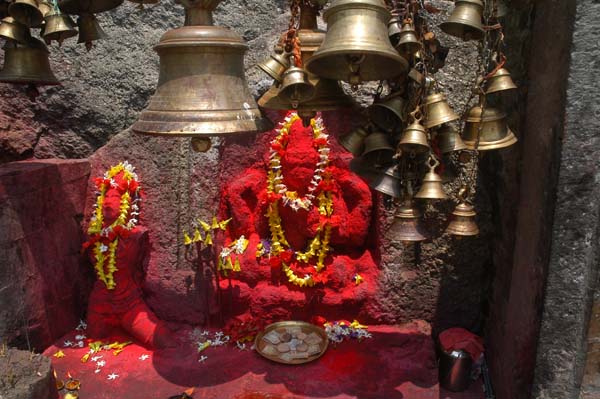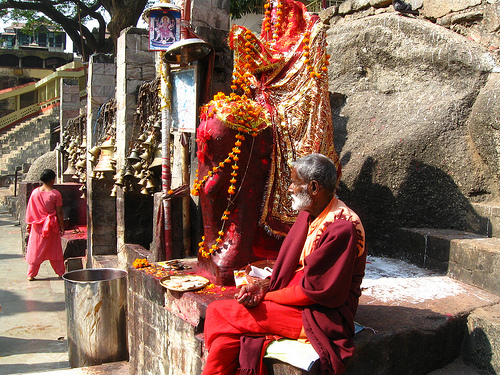ॐ श्री गुरुभ्यो नमः ॐ श्री शिवानन्दाय नमः ॐ श्री चिदानन्दाय नमः ॐ श्री दुर्गायै नमः
Source of all Images in this Blog-post : Google Images : ‘Google Image Search’ will reveal the multiple sources of every single image shared in this Blog. For more details, kindly see ‘Disclaimer‘
Official Website of Shri Kamakhya Temple, Guwahati

The Kamakhya Temple also known as Kamrup-Kamakhya temple , is a Shakta temple dedicated to the Mother Goddess Kamakhya. It is one of the oldest of the 51 Shakti Pithas of India.

Situated on the Nilachal Hill in the western part of Guwahati city in the Indian state of Assam, it is the main temple in a complex of individual temples dedicated to the ten Mahavidyas of Saktism : Kali, Tara, Sodashi, Bhuvaneshwari, Bhairavi, Chhinnamasta, Dhumavati, Bagalamukhi, Matangi and Kamalatmika.
Among these, Tripurasundari, Matangi and Kamala reside inside the main temple whereas the other seven reside in individual temples. It is an important pilgrimage destination for Hindus and especially for Tantric worshipers.
In July 2015, the Supreme Court of India transferred the administration of the Temple from the Kamakhya Debutter Board to the Bordeuri Samaj.


Description :
The current structural temple, built and renovated many times in the period 8th-17th century, gave rise to a hybrid indigenous style that is sometimes called the Nilachal type : A temple with a hemispherical dome on a cruciform base.
The temple consists of four chambers: Garbhagriha and three Mandapas locally called Calanta, Pancharatna and Natamandira aligned from east to west.


Vimana :
The Vimana over the Garbhagriha has a Pancharatha plan that rests on plinth moldings that are similar to the Surya Temple at Tezpur. The panels have delightful sculptured Ganesha and other Hindu gods and goddesses.

The inner Sanctum within the Vimana, the Garbhagriha, is below ground level and consists of no image but a rock fissure in the shape of a Yoni (female genital).
The Garbhagriha is small, dark and reached by narrow steep stone steps. Inside the cave there is a sheet of stone that slopes downwards from both sides meeting in a Yoni-like depression some 10 inches deep.
This hollow is constantly filled with water from an underground perennial spring. It is the vulva-shaped depression that is worshiped as the goddess Kamakhya herself and considered as most important Shakti Peetha (Most Sacred Abode of the Devi).
The Garbhaghrihas of the other temples in the Kamakhya complex follow the same structure, Yoni-shaped stone, filled with water and below ground level.
History :
The traditional accounts from Kalika Purana and the Yogini Tantra record that the Goddess Kamakhya is of Kirata origin. The tradition of sacrifices continue even today with devotees coming every morning with animals and birds to offer to the goddess.
Worship :
The Kalika Purana, an ancient work in Sanskrit describes Kamakhya as the yielder of all desires, the young bride of Shiva, and the giver of salvation. Shakti is known as Kamakhya.
Goddess Kamakhya is worshiped according to both the Vamachara (Left-Hand Path) as well as the Dakshinachara (Right-Hand Path) modes of Tantrik worship.[
Offerings to the goddess are usually flowers, but might include animal sacrifices as well. In general female animals are exempt from sacrifice, a rule that is relaxed during mass sacrifices.
Legends :
According to the Kalika Purana, Kamakhya Temple denotes the spot where Sati used to retire in secret to satisfy her amour with Shiva, and it was also the place where her Yoni (genital) fell after Shiva danced with the corpse of Sati.
It mentions Kamakhya as one of four primary Shakti-Peethas; the other three being the Vimala Temple within the Jagannath Temple complex in Puri, Odisha; Tara Tarini Sthana Khanda (Breasts), near Brahmapur, Odisha, and Dakhina Kalika in Kalighat, Kolkata, in the state of West Bengal, originated from the limbs of the corpse of Mata Sati.
This is not corroborated in the Hindu scripture Devi Bhagavata, which lists 108 places associated with Sati’s body, though Kamakhya finds a mention in a supplementary list.
Festivals :
Being the centre for Tantra worship this temple attracts thousands of tantra devotees in an annual festival known as the Ambubachi Mela. Another annual celebration is the Manasha Puja.
Durga Puja is also celebrated annually at Kamakhya during Navaratri in the autumn. This five-day festival attracts several thousand visitors.
Read more about this sacred Shakti-Peetha temple on its Wikipedia page by clicking this link
